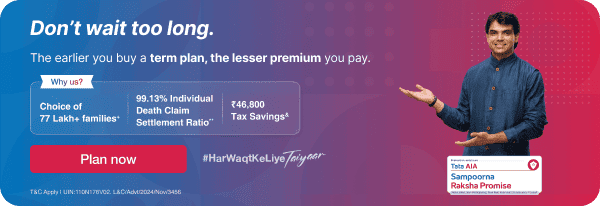The complete name of Tata AIA Sampoorna Raksha Promise is Tata AIA Sampoorna Raksha Promise - Non-Linked, Non-Participating, pure risk, Individual Life Insurance Product (UIN:110N176V05)
The complete name of Tata AIA Maha Raksha Supreme Select is Tata AIA Maha Raksha Supreme Select - Non-Linked, Non-Participating, Pure Risk, Individual Life Insurance Product (UIN: 110N171V08)
*Illustrated Premium is the monthly premium excluding taxes for 20 yr. old female, Standard Life, Non-Smoker for ₹ 1 Cr. Sum Assured with Policy Term of 20 yrs. (Regular Pay) under Life Promise Option with first year premium discount for digital purchase and salaried person. Please refer Benefit Illustration for more details. Premium is subject to applicable taxes, cesses & levies which will be entirely borne/ paid by the Policyholder, in addition to the payment of such Premium. Tata AIA Life shall have the right to claim, deduct, adjust, recover the amount of any applicable tax or imposition, levied by any statutory or administrative body, from the benefits payable under the Policy. Kindly refer the sales illustration for the exact premium.
@Not applicable under PoS, please refer sales brochure for more information
~This product offers an additional first year premium discount of 2% for Limited/Regular Pay and 0.5% for Single Pay on reaching any one of the below mentioned life milestones:
1. Marriage - if policy is purchased within 6 months before or after the date of marriage
2. Childbirth/adoption - if policy is purchased within 6 months before or after the birth/adoption date
3. First job - if policy is purchased within next 6 months of the joining date
4. Home loan - if policy is purchased within next 6 months of the loan getting sanctioned
Such discount is capped to a maximum of Rs. 500 over the year
+Tax benefits of up to ₹46,800 u/s 80C is calculated at highest tax slab rate of 31.20% (including cess excluding surcharge) on life insurance premium paid of ₹1,50,000. Tax benefits under the policy are subject to conditions laid under Section 80C, 80D,10(10D), 115BAC and other applicable provisions of the Income Tax Act,1961. Good and Service tax and Cess if any will be charged extra as per prevailing rates. The Tax Free income is subject to conditions specified under section 10(10D) and other applicable provisions of the Income Tax Act,1961. Tax laws are subject to amendments made thereto from time to time. Please consult your tax advisor for details, before acting on above.
^Rider is not mandatory and is available for a nominal extra cost. For more details on benefits, premiums, and exclusions under the Rider, please contact Tata AIA Life's Insurance Advisor/ branch.
#Income Tax benefits would be available as per the prevailing income tax laws, subject to fulfillment of conditions stipulated therein. Income Tax laws are subject to change from time to time. Tata AIA Life Insurance Company Ltd. does not assume responsibility on tax implication mentioned anywhere in this document. Please consult your own tax consultant to know the tax benefits available to you.
$Under Life Promise Plus Option, an amount equal to the 100% of the Total Premiums Paid (excluding loading for modal premiums) shall be payable at the end of the Policy Term, provided the life assured survives till maturity and the policy is not terminated earlier.
1Individual Death Claim Settlement Ratio is 99.13% for FY 2023 - 24 as per the latest annual audited figures.
2Applicable to only non-early claims with more than 3 years of policy duration, non-investigation cases, up to Sum Assured of Rs. 50 lakhs. Applicable for branch walk in. Time limit to submit claim to Tata AIA Life Insurance is 2 pm on working days. Subject to submission of complete documents. Not applicable for ULIP policies and open title claims.
385,76,889 families protected till 31st December 2024.
4As on 31st December 2024, the company has a total Assets Under Management (AUM) of ₹119,602.78 Crores
5This includes first year digital discount of 10% for Limited Pay/Regular Pay and 8.5% salaried discount. For Single Pay, 1% discount will be available for online purchase and salaried discount each.
6Illustrated Premium is the monthly premium excluding taxes for 20 yr. old female, Standard Life, Non-Smoker for 2 Cr. Sum Assured with Policy Term of 20 yrs. (Regular Pay) with Life Secure plan option salaried person. Please refer Benefit Illustration for more details. Tata AIA Life shall have the right to claim, deduct, adjust, recover the amount of any applicable tax or imposition, levied by any statutory or administrative body, from the benefits payable under the Policy. Kindly refer the sales illustration for the exact premium
This product is underwritten by Tata AIA Life Insurance Company Ltd.
The plan is not a guaranteed issuance plan and it will be subject to company’s underwriting and acceptance.
Insurance cover is available under this product.
For more details on risk factors, terms and conditions please read sales brochure carefully before concluding a sale. The precise terms and condition of this plan are specified in the Policy Contract.
Buying a Life Insurance Policy is a long-term commitment. An early termination of the Policy usually involves high costs and the Surrender Value payable may be less than the all the Premiums Paid.
In case of non-standard lives and on submission of non-standard age proof, extra premiums will be charged as per our underwriting guidelines.
L&C/Advt/2025/Mar/1553

 FOR EXISTING POLICY
FOR EXISTING POLICY  1860 266 9966
1860 266 9966
 FOR NEW POLICY
FOR NEW POLICY 














 Reviewed by
Reviewed by
